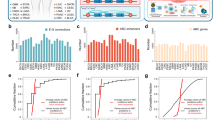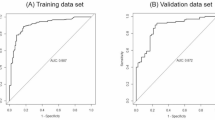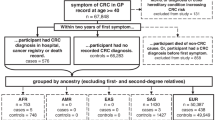Abstract
Background
The presence of peritoneal metastasis (PM) in colorectal cancer (CRC) patients indicates an advanced CRC stage. Prompt diagnosis and early PM detection are difficult, and the underlying mechanisms are unclear, resulting in limited treatment options and unsatisfactory therapeutic effects. We aimed to identify applicable biomarkers for accurately diagnosing synchronous PM in CRC patients.
Methods
Differentially expressed genes between synchronous and non-synchronous PM groups were identified via label-free proteomic analysis of primary tumors from 31 CRC patients. Quantitative real-time PCR, multiplex and conventional immunohistochemistry were used to validate gene expression. We attempted to construct a logistic regression risk model for the diagnosis of PM, which was tested in a training cohort and validated in an independent cohort.
Results
Utilizing the results from multi-omics, we established an ABCC1-based risk model. In CRC patients with imaging-negative diagnoses, the model identified patients with metastases including PM (AUC = 0.892, 95% CI: 0.840–0.944) or those with PM only (AUC = 0.859, 95% CI: 0.794–0.924); these results were validated in an independent cohort of patients with metastases including PM (AUC = 0.831, 95% CI: 0.729–0.933) or PM only (AUC = 0.819, 95% CI: 0.702–0.936). In CRC patients with CEA-negative, this model more effectively distinguishes those with exclusive peritoneal involvement, with consistent results across both training (AUC = 0.913, 95% CI: 0.854–0.972) and validation (AUC = 0.869, 95% CI: 0.795–0.943) cohorts. Additionally, in CRC patients with PM, low ABCC1 may serve as a predictive marker for chemotherapy efficacy.
Conclusions
The ABCC1-based risk model effectively predicts PM in CRC, complementing traditional diagnostics. ABCC1 may serve as a predictive marker for chemotherapy efficacy in PM.
This is a preview of subscription content, access via your institution
Access options
Subscribe to this journal
Receive 24 print issues and online access
$259.00 per year
only $10.79 per issue
Buy this article
- Purchase on SpringerLink
- Instant access to full article PDF
Prices may be subject to local taxes which are calculated during checkout





Similar content being viewed by others
Data availability
The Proteomics datasets supporting the conclusions of this article have been uploaded to the iProx Consortium with the project ID IPX0006751000. All other data that support the findings of this study are available from the corresponding authors upon reasonable request.
References
Gerstberger S, Jiang Q, Ganesh K. Metastasis. Cell. 2023;186:1564–79.
Bray F, Laversanne M, Sung H, Ferlay J, Siegel RL, Soerjomataram I, et al. Global cancer statistics 2022: GLOBOCAN estimates of incidence and mortality worldwide for 36 cancers in 185 countries. CA: a cancer journal for clinicians https://doi.org/10.3322/caac.21834 (2024).
Jayne DG, Fook S, Loi C, Seow-Choen F. Peritoneal carcinomatosis from colorectal cancer. Br J Surg. 2002;89:1545–50.
Arrizabalaga NB, Navascués JME, Echaniz GE, Ansorena YS, Galán CP, Martín XA, et al. Prophylactic HIPEC in pT4 colon tumors: proactive approach or overtreatment?. Ann Surg Oncol. 2020;27:1094–1100.
Franko J, Shi Q, Meyers JP, Maughan TS, Adams RA, Seymour MT, et al. Prognosis of patients with peritoneal metastatic colorectal cancer given systemic therapy: an analysis of individual patient data from prospective randomised trials from the Analysis and Research in Cancers of the Digestive System (ARCAD) database. Lancet Oncol. 2016;17:1709–19.
Glehen O, Gilly FN, Arvieux C, Cotte E, Boutitie F, Mansvelt B, et al. Peritoneal carcinomatosis from gastric cancer: a multi-institutional study of 159 patients treated by cytoreductive surgery combined with perioperative intraperitoneal chemotherapy. Ann Surg Oncol. 2010;17:2370–7.
Verwaal VJ, van Ruth S, de Bree E, van Sloothen GW, van Tinteren H, Boot H, et al. Randomized trial of cytoreduction and hyperthermic intraperitoneal chemotherapy versus systemic chemotherapy and palliative surgery in patients with peritoneal carcinomatosis of colorectal cancer. J Clin Oncol. 2003;21:3737–43.
Lin T, Chen X, Xu Z, Hu Y, Liu H, Yu J, et al. Laparoscopic cytoreductive surgery and hyperthermic intraperitoneal chemotherapy for gastric cancer with intraoperative detection of limited peritoneal metastasis: a Phase II study of CLASS-05 trial. Gastroenterol Rep. 2024;12:goae001.
van ‘t Sant I, Engbersen MP, Bhairosing PA, Lambregts DMJ, Beets-Tan RGH, van Driel WJ, et al. Diagnostic performance of imaging for the detection of peritoneal metastases: a meta-analysis. Eur Radio. 2020;30:3101–12.
Carlson B, Harmath C, Turaga K, Kindler HL, Armato SG 3rd, Straus C. The role of imaging in diagnosis and management of malignant peritoneal mesothelioma: a systematic review. Abdom Radio. 2022;47:1725–40.
Koh JL, Yan TD, Glenn D, Morris DL. Evaluation of preoperative computed tomography in estimating peritoneal cancer index in colorectal peritoneal carcinomatosis. Ann Surg Oncol. 2009;16:327–33.
Nicholson BD, Shinkins B, Pathiraja I, Roberts NW, James TJ, Mallett S, et al. Blood CEA levels for detecting recurrent colorectal cancer. Cochrane Database Syst Rev. 2015;2015:Cd011134.
Webb A, Scott-Mackie P, Cunningham D, Norman A, Andreyev J, O’Brien M, et al. The prognostic value of CEA, beta HCG, AFP, CA125, CA19-9 and C-erb B-2, beta HCG immunohistochemistry in advanced colorectal cancer. Ann Oncol. 1995;6:581–7.
Shen D, Wang X, Wang H, Xu G, Xie Y, Zhuang Z, et al. Current surveillance after treatment is not sufficient for patients with rectal cancer with negative baseline CEA. J Natl Compr Cancer Netw: JNCCN. 2022;20:653–662.e653.
Kyriazi S, Kaye SB, deSouza NM. Imaging ovarian cancer and peritoneal metastases-current and emerging techniques. Nat Rev Clin Oncol. 2010;7:381–93.
Dochez V, Caillon H, Vaucel E, Dimet J, Winer N, Ducarme G. Biomarkers and algorithms for diagnosis of ovarian cancer: CA125, HE4, RMI and ROMA, a review. J Ovarian Res. 2019;12:28.
Laoukili J, Constantinides A, Wassenaar ECE, Elias SG, Raats DAE, van Schelven SJ, et al. Peritoneal metastases from colorectal cancer belong to Consensus Molecular Subtype 4 and are sensitised to oxaliplatin by inhibiting reducing capacity. Br J Cancer. 2022;126:1824–33.
Cortés-Guiral D, Hübner M, Alyami M, Bhatt A, Ceelen W, Glehen O, et al. Primary and metastatic peritoneal surface malignancies. Nat Rev Dis Prim. 2021;7:91.
Zhang M, Cheng S, Jin Y, Zhao Y, Wang Y. Roles of CA125 in diagnosis, prediction, and oncogenesis of ovarian cancer. Biochim et Biophys Acta Rev cancer. 2021;1875:188503.
Bankhead P, Loughrey MB, Fernández JA, Dombrowski Y, McArt DG, Dunne PD, et al. QuPath: open source software for digital pathology image analysis. Sci Rep. 2017;7:16878.
Camp RL, Dolled-Filhart M, Rimm DL. X-tile: a new bio-informatics tool for biomarker assessment and outcome-based cut-point optimization. Clin Cancer Res. 2004;10:7252–9.
Yeong J, Tan T, Chow ZL, Cheng Q, Lee B, Seet A, et al. Multiplex immunohistochemistry/immunofluorescence (mIHC/IF) for PD-L1 testing in triple-negative breast cancer: a translational assay compared with conventional IHC. J Clin Pathol. 2020;73:557–62.
Lennon AM, Buchanan AH, Kinde I, Warren A, Honushefsky A, Cohain AT, et al. Feasibility of blood testing combined with PET-CT to screen for cancer and guide intervention. Science. 2020;369:eabb9601.
Wang Q, Liu W, Chen S, Luo Q, Li Y, Peng S, et al. ORMDL1 is upregulated and associated with favorable outcomes in colorectal cancer. Transl Oncol. 2021;14:101171.
Liu W, Chen S, Xie W, Wang Q, Luo Q, Huang M, et al. MCCC2 is a novel mediator between mitochondria and telomere and functions as an oncogene in colorectal cancer. Cell Mol Biol Lett. 2023;28:80.
Celestino Pinto L, de Fátima Aquino Moreira-Nunes C, Soares BM, Burbano RMR, de Lemos JAR, Montenegro RC. Mebendazole, an antiparasitic drug, inhibits drug transporters expression in preclinical model of gastric peritoneal carcinomatosis. Toxicol Vitr. 2017;43:87–91.
Shi WK, Liu YX, Qiu XY, Zhou JY, Zhou JL, Lin GL. Construction and validation of a novel Ferroptosis-related gene signature predictive model in rectal Cancer. BMC Genom. 2022;23:764.
Pan B, Yang Y, Li J, Wang Y, Fang C, Yu FX, et al. USP47-mediated deubiquitination and stabilization of YAP contributes to the progression of colorectal cancer. Protein cell. 2020;11:138–43.
Schalper KA, Carvajal-Hausdorf D, McLaughlin J, Altan M, Velcheti V, Gaule P, et al. Differential expression and significance of PD-L1, IDO-1, and B7-H4 in human lung cancer. Clin Cancer Res. 2017;23:370–8.
Jiang Y, Zhang Q, Hu Y, Li T, Yu J, Zhao L, et al. ImmunoScore signature: a prognostic and predictive tool in gastric cancer. Ann Surg. 2018;267:504–13.
Anwaier A, Zhu S-X, Tian X, Xu W-H, Wang Y, Palihati M, et al. Large-scale proteomics data reveal integrated prognosis-related protein signatures and role of SMAD4 and RAD50 in prognosis and immune infiltrations of prostate cancer microenvironment. Phenomics. 2022;2:404–18.
Akhoundova D, Rubin MA. Clinical application of advanced multi-omics tumor profiling: Shaping precision oncology of the future. Cancer cell. 2022;40:920–38.
Liu SL, Bian LJ, Liu ZX, Chen QY, Sun XS, Sun R, et al. Development and validation of the immune signature to predict distant metastasis in patients with nasopharyngeal carcinoma. J Immunother Cancer. 2020;8:e000205.
Guo C, Zhao H, Wang Y, Bai S, Yang Z, Wei F, et al. Prognostic value of the neo-immunoscore in renal cell carcinoma. Front Oncol. 2019;9:439.
Robey RW, Pluchino KM, Hall MD, Fojo AT, Bates SE, Gottesman MM. Revisiting the role of ABC transporters in multidrug-resistant cancer. Nat Rev Cancer. 2018;18:452–64.
Cole SP. Targeting multidrug resistance protein 1 (MRP1, ABCC1): past, present, and future. Annu Rev Pharm Toxicol. 2014;54:95–117.
Zhou J, Guo T, Zhou L, Bao M, Wang L, Zhou W, et al. The ferroptosis signature predicts the prognosis and immune microenvironment of nasopharyngeal carcinoma. Sci Rep. 2023;13:1861.
Iwasaki K, Cho H, Maezawa Y, Tsuchida K, Kano K, Fujikawa H, et al. Assessment of the use of computed tomography colonography in early detection of peritoneal metastasis in patients with gastric cancer: a prospective cohort study. PloS ONE. 2022;17:e0261527.
Sato K, Imaizumi K, Kasajima H, Kurushima M, Umehara M, Tsuruga Y, et al. Comparison of prognostic impact between positive intraoperative peritoneal and lavage cytologies in colorectal cancer. Int J Clin Oncol. 2021;26:1272–84.
Yuan Z, Chen W, Liu D, Qin Q, Grady WM, Fichera A, et al. Peritoneal cell-free DNA as a sensitive biomarker for detection of peritoneal metastasis in colorectal cancer: a prospective diagnostic study: A prospective diagnostic study. Clin Epigenet. 2023;15:65.
Wang H, Zheng Q, Lu Z, Wang L, Ding L, Xia L, et al. Role of the nervous system in cancers: a review. Cell Death Discov. 2021;7:76.
Acknowledgements
The authors would like to express their sincere gratitude to Dr. Lishuo Shi, Huanmiao Zhan, and Hongfei Liang for their invaluable contributions in statistical consultation and follow-up update. Moreover, With the greatest respect, this article is dedicated to and in memorial of Professor Lei Wang, who was the formal vice president of our hospital.
Funding
This work was financially supported by the Natural Science Foundation of China (Grant No. 31970703), Natural Science Foundation of Guangdong Province (Grant No. 2022A1515012472 and 2025A1515010593), and supported by National Key Clinical Discipline and the Program.
Author information
Authors and Affiliations
Contributions
Conception or design of the work: DC Chen and P Lan; data collection: WQ Xie, QX Luo, Q Wang, ZM Ou; data analysis and interpretation: WQ Xie and ZM Ou; drafting the article: WQ Xie, QX Luo, and DC Chen; critical revision of the article: DC Chen, P Lan, WQ Xie, QX Luo, ZM Ou, WJ Liu, MH Huang; final approval of the version to be published: all the authors.
Corresponding authors
Ethics declarations
Competing interests
The authors declare no competing interests.
Ethics approval and consent to participate
All procedures were conducted in accordance with the Declaration of Helsinki and approved by the Human Medical Ethics Committee of the Sixth Affiliated Hospital of Sun Yat-sen University (approval number: 2022ZSLYEC-469). This study is a retrospective study and the information are anonymous. The authors had no access to any identifying information during the analysis of the data. In accordance with the relevant guidelines and regulations, the requirement for informed consent was waived.
Additional information
Publisher’s note Springer Nature remains neutral with regard to jurisdictional claims in published maps and institutional affiliations.
Supplementary information
Rights and permissions
Springer Nature or its licensor (e.g. a society or other partner) holds exclusive rights to this article under a publishing agreement with the author(s) or other rightsholder(s); author self-archiving of the accepted manuscript version of this article is solely governed by the terms of such publishing agreement and applicable law.
About this article
Cite this article
Xie, W., Luo, Q., Ou, Z. et al. An ABCC1-based risk model is effective in the diagnosis of synchronous peritoneal metastasis in advanced colorectal cancer. Br J Cancer (2025). https://doi.org/10.1038/s41416-025-03203-1
Received:
Revised:
Accepted:
Published:
DOI: https://doi.org/10.1038/s41416-025-03203-1



